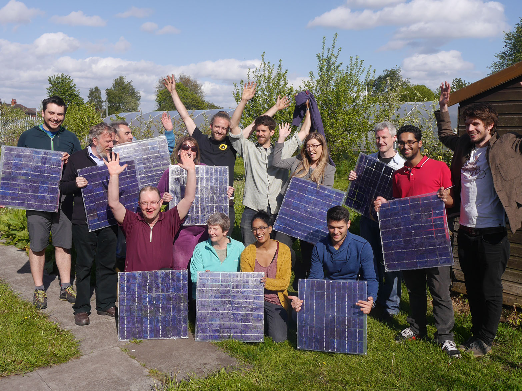
Lake Louise Energy Co-op
Status: New Project
Seeking:
0 people support this project!
Here's a sample project to help inspire new projects!
Volunteers needed to help raise money for a community-owned energy cooperative! Sample Project
By Thrivespring
Do you live in Lake Louise? Would you like to increase your community's disaster resilience by helping to raise money for a community-owned renewable energy microgrid?
Community microgrids are a new approach for grid operations that achieve a sustainable, secure, and cost-effective energy system by providing long-term, locally generated power security prioritized for the community. Microgrids have the ability to separate from the larger electrical grid during extreme weather events or other emergencies, providing the backbone for a resilient, sustainable and more efficient energy production of the future.
A group of local residents are working together to create a community-owned microgrid in Lake Louise. The goals of the Lake Louise Energy Co-op are as follows:
- Increase the amount of clean, renewable energy generated in the community by members of the community
- Develop a connected network of distributed energy resources which will improve electrical grid resiliency and efficiency
- Manage our distributed energy resource in times of power outages and emergencies to protect the community and local economy
- Create financial incentives and business models that encourage community investment in our energy future, creating energy and jobs that boost the local economy
Need some examples of how microgrids increase disaster resilience?
Following the 2011 tsunami in Japan, some parts of the city of Higashimatsushima didn’t get electricity for up to three months. During the recovery efforts, the city decided to create a safe, resilient and sustainable society by deploying distributed, clean renewable energy sources. Now, when disconnected from the traditional grid, the town can supply three day’s worth of everyday energy needs for residents and buildings in the town. During a prolonged power failure, the town can still provide minimum energy needs for the hospitals and assembly hall. And the community can not only provide backup power for the grid in case of emergencies, but can allow the community to be more energy independent and environmentally friendly.
A community in the city of Rutland, Vermont, which experienced power outages during Hurricane Sandy, decided to take matters into its own hands by implementing a solar-powered microgrid. The project included 2.5 MW of solar capacity, along with 4 MW of battery storage, which can supply electricity for approximately 365 homes.
A neighborhood in the California desert city of Borrego Springs is utilizing community energy storage and 700 kW of distributed rooftop solar PV to improve energy reliability and resilience. This system is comprised of distributed generation, energy storage units, and island-enabling control technologies. It has demonstrated successful islanding and provided power during scheduled and weather-related outages.
Energy independence on a micro-scale is clearly the way forward, so let's get cracking on setting an example for the rest of the country by creating a co-operatively owned microgrid to build a more resilient, sustainable and energy efficient community.
Photo credit: https://www.flickr.com/photos/tentenuk/18489240870/in/dateposted/
(THIS IS A SAMPLE PROJECT ONLY)
Community microgrids are a new approach for grid operations that achieve a sustainable, secure, and cost-effective energy system by providing long-term, locally generated power security prioritized for the community. Microgrids have the ability to separate from the larger electrical grid during extreme weather events or other emergencies, providing the backbone for a resilient, sustainable and more efficient energy production of the future.
A group of local residents are working together to create a community-owned microgrid in Lake Louise. The goals of the Lake Louise Energy Co-op are as follows:
- Increase the amount of clean, renewable energy generated in the community by members of the community
- Develop a connected network of distributed energy resources which will improve electrical grid resiliency and efficiency
- Manage our distributed energy resource in times of power outages and emergencies to protect the community and local economy
- Create financial incentives and business models that encourage community investment in our energy future, creating energy and jobs that boost the local economy
Need some examples of how microgrids increase disaster resilience?
Following the 2011 tsunami in Japan, some parts of the city of Higashimatsushima didn’t get electricity for up to three months. During the recovery efforts, the city decided to create a safe, resilient and sustainable society by deploying distributed, clean renewable energy sources. Now, when disconnected from the traditional grid, the town can supply three day’s worth of everyday energy needs for residents and buildings in the town. During a prolonged power failure, the town can still provide minimum energy needs for the hospitals and assembly hall. And the community can not only provide backup power for the grid in case of emergencies, but can allow the community to be more energy independent and environmentally friendly.
A community in the city of Rutland, Vermont, which experienced power outages during Hurricane Sandy, decided to take matters into its own hands by implementing a solar-powered microgrid. The project included 2.5 MW of solar capacity, along with 4 MW of battery storage, which can supply electricity for approximately 365 homes.
A neighborhood in the California desert city of Borrego Springs is utilizing community energy storage and 700 kW of distributed rooftop solar PV to improve energy reliability and resilience. This system is comprised of distributed generation, energy storage units, and island-enabling control technologies. It has demonstrated successful islanding and provided power during scheduled and weather-related outages.
Energy independence on a micro-scale is clearly the way forward, so let's get cracking on setting an example for the rest of the country by creating a co-operatively owned microgrid to build a more resilient, sustainable and energy efficient community.
Photo credit: https://www.flickr.com/photos/tentenuk/18489240870/in/dateposted/
(THIS IS A SAMPLE PROJECT ONLY)